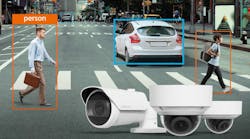The Liberty School District (Missouri) is looking at stepping up a high-tech effort to catch motorists who run school bus stop signs, an initiative that has gained momentum in the wake of the fatal school bus crash this month.
The plan, said assistant superintendent Phil Wright, is to outfit each of the district's 74 buses with a digital camera system that will not only monitor bus passengers, but also will capture images of vehicles that don't heed bus stop signs.
The discovery that the camera on board bus No. 80 was not working as the bus hurtled through the busy intersection of Missouri 152 and Missouri 291 on May 9 demonstrated to the district that it needs more reliable cameras.
"This situation just kind of crystallizes it for us," Wright said. "We need cameras working all the time."
The bus crashed after it veered into the two motorists, killing them and injuring dozens of students on board the bus, three of whom remained hospitalized Tuesday.
The cause of the accident remains under investigation.
Investigators have said video from bus No. 80's camera would have been helpful in the crash investigation, but its availability was not crucial to the task.
District buses now have VCR-style cameras on board to monitor student behavior.
One drawback to them, Wright said, is that it is hard to know by doing a visual check whether they are working properly.
He said new digital cameras the district is considering purchasing have a light that will be off if the camera is not functioning properly.
One other benefit, he said, is that one of the system's four cameras would be pointed out the front window to catch oncoming motorists who run the bus' stop signs.
"I think it would cut those way down," said Superintendent Scott Taveau.
The school board would have to approve spending for the cameras, which could cost about $220,000, but Taveau was confident the board would approve the expenditure.
Wright said he hoped to have a proposal ready for board action by next month.
The digital image can capture a vehicle's license plate number, which allows law enforcement authorities to identify the owner and issue a citation through the mail.
The district has been experimenting with the new technology on two of its buses this year, and Wright said at least six tickets have been issued.
"We are very pleased with it," Wright said.
So much so that just four days before the bus crash, the district received price quotes on the four-camera system.
As with other security enhancements, Wright said the money would come from the district's vending revenues.
Along with the capability to catch law breakers, the new cameras would capture a wealth of information that could prove helpful in the event of another accident, including when and if the brake pedal was activated.
Bus cameras are not the only thing the district is dealing with after the bus crash.
The district also is sorting out insurance issues.
Its policy will pay $5,000 for each student injured.
On top of that, Wright said the district is hoping that another one of its insurance policies will allow it to pay all the out-of-pocket expenses incurred by the families of injured students.
"I think we'll be able to get it done," he said.
But it likely will not come cheap.
Asked how much such an initiative would cost the district, Wright said: "I don't have any idea. It could be a lot. Some of them (the students) are still in ICU."

